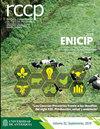饲粮中添加胍基乙酸对肉鸡生产性能的影响
IF 0.5
4区 农林科学
Q4 AGRICULTURE, DAIRY & ANIMAL SCIENCE
引用次数: 1
摘要
背景:肌酸及其前体,胍基乙酸(GAA),减少蛋白质降解,避免氨基酸抵消糖异生。目的:研究饲粮中添加GAA对1 ~ 21日龄肉仔鸡生产性能、消化率和血液指标的影响。方法:选用1日龄肉鸡252只,采用完全随机设计,7个重复,每个试验单元12只。各组分别在基础饲粮中添加0.10和0.20% GAA。结果:第1 ~ 7天,饲粮添加0.20% GAA的肉鸡饲料系数有提高趋势(p<0.10)。在第7 ~ 14天,饲料中添加0.20% GAA的动物的FC得到改善,并且有改善增重的趋势。0.20% GAA组动物血肌酸激酶浓度升高。第6天,两组间的血肌酸和血糖没有差异。饲粮添加0.20% GAA后,第3 ~ 7天粗蛋白质同化系数增加。在17 ~ 21 d期间,处理间无差异。肠道重量和长度无显著差异。结论:前期饲粮中添加0.20% GAA可提高1 ~ 14日龄肉仔鸡增重和饲料系数。本文章由计算机程序翻译,如有差异,请以英文原文为准。
Effect of dietary inclusion of guanidinoacetic acid on broiler performance
Background: Creatine and its precursor, guanidinoacetic acid (GAA), decrease protein degradation, avoiding amino acid offset to gluconeogenesis. Objective: To evaluate the inclusion of GAA in the pre-initial diet (1 to 7 days) on performance, digestibility, and blood parameters of broilers from one to 21 days of age. Methods: 252 male broiler chickens aged one day were distributed in a completely randomized design with seven replicates and 12 animals per experimental unit. Treatments consisted of a basal diet, and the basal added with 0.10 and 0.20% GAA. Results: From days 1 to 7, a tendency on improved feed conversion (FC) was observed for broilers receiving 0.20% GAA (p<0.10). Between 7 and 14 days, FC improved, as well as a tendency was observed on improved weight gain in animals fed 0.20% GAA. Animals that received 0.20% GAA showed higher blood concentrations of creatine kinase. Blood creatine and blood glucose did not differ between treatments at day six. The assimilation coefficient of crude protein increased during days 3 to 7 for animals receiving 0.20% GAA. On the period between 17 and 21 days, no difference was observed between treatments. Intestinal weight and length did not show significant differences. Conclusion: Dietary inclusion of 0.20% GAA during the pre-initial stage could improve weight gain and feed conversion of broilers between 1 and 14 days of age.
求助全文
通过发布文献求助,成功后即可免费获取论文全文。
去求助
来源期刊

Revista Colombiana De Ciencias Pecuarias
AGRICULTURE, DAIRY & ANIMAL SCIENCE-
CiteScore
0.80
自引率
0.00%
发文量
18
审稿时长
6-12 weeks
期刊介绍:
The editors of Revista Colombiana de Ciencias Pecuarias (RCCP) welcome the submission of original manuscripts on experimental and clinical studies associated with the broad areas of animal sciences and veterinary medicine as they interface with biochemistry, molecular biology, physiology, pharmacology, toxicology, pathology, microbiology, parasitology, immunology and epidemiology. The scope of the journal includes studies of basic and applied research in animal management and production, feeding and nutrition, reproduction, breeding, genetics, animal welfare and behavior; as well as animal production focussed from biotechnology, soil science, agrostology, silvopastoral systems, livestock economics and the environment.
The criteria for acceptance of papers submitted for publication are originality, quality and clarity of the content. Each contribution must be based on original, unpublished research that has not been simultaneously submitted to other journals. All papers will be peer reviewed. All authors bear responsibility for ensuring the integrity and quality of their reported research. It is the author''s responsibility to secure permission to use figures or tables that have been published elsewhere.
Contributions may be classified as original research, review, rapid communication, clinical case studies or methodological articles, as well as news/commentaries or letters to the editor. Most review articles are invited by the editor. Authors interested in submitting a review article should contact the corresponding editor. Rapid publication of original manuscripts is a goal of the journal. Manuscripts must be written in English. Each manuscript is considered for publication with the understanding that it has not been simultaneously submitted to any other journal. Upon acceptance for publication, papers are subject to editorial review and revision.
 求助内容:
求助内容: 应助结果提醒方式:
应助结果提醒方式:


